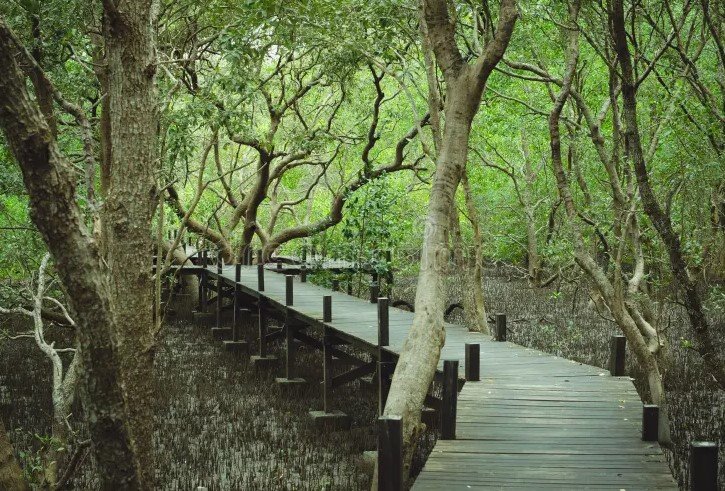Once overshadowed by industry, rural districts on Ho Chi Minh City’s edge are becoming fertile ground for high-tech agriculture—and farmers are reaping the rewards
Cần Giờ’s mangoes used to be sold by the roadside for pennies. Now, they’re certified, traceable, and being exported thanks to drip irrigation, sensors, and clever farming know-how. This isn’t a rustic anomaly—it’s the blueprint for something bigger.
From Bình Chánh to Bà Rịa – Vũng Tàu, suburban farming districts on the outskirts of Vietnam’s economic heartland are turning into mini agri-tech hubs. And this transformation isn’t just cosmetic—it’s about economic survival, ecological balance, and smarter food systems.
A quiet revolution in fruit orchards and shrimp ponds
Đoàn Thanh Tường has been farming mangoes in Cần Giờ for decades. He’s seen sea levels inch up and urban sprawl creep in. But today, his 5,000 square meters of mango trees stand out—not for their size, but their method.
He’s 66, but Tường knows his way around automated irrigation systems. His farm runs on VietGAP standards, using minimal pesticides and maximizing soil health.
It’s not just for show.
He produces four tonnes of mangoes each year, supplying both domestic and international markets. “I just wanted better fruit,” he shrugs. “Now it’s become something bigger.”
Tường’s success has encouraged others. In the same commune, shrimp farmers are experimenting with smart water filtration and feed controls. These aren’t giant industrial setups. They’re often two- or three-hectare plots run by local families.

The bigger strategy: Suburbs as agriculture’s new frontier
Ho Chi Minh City’s rural face isn’t just evolving on its own. City planners are in on it.
Authorities are reimagining what the suburbs can be. Instead of surrendering green belts to concrete, they’re doubling down on land for food production—with a tech twist.
Officials have been zoning peri-urban districts specifically for high-tech farming, especially in places like:
-
Bình Chánh: famous for leafy greens and herbs, now experimenting with sensor-based fertigation.
-
Hóc Môn: where co-ops are piloting AI-assisted vegetable grading.
-
Nhà Bè: known for rice, now testing aerial drones for disease detection.
This isn’t just about making farming “cool.” It’s about survival.
HCM City’s core is choking under the pressure of growth. Pushing sustainable, tech-driven agriculture to the edges creates economic activity, cuts transport needs, and strengthens the city’s food resilience.
Show me the numbers: Agriculture still matters
It’s easy to forget agriculture’s role in a megacity like HCM City. But let’s crunch some stats:
| Year | Agricultural Output (VND Trillion) | % Using High-Tech Methods | Rural Employment (Thousands) |
|---|---|---|---|
| 2020 | 13.2 | 18% | 198 |
| 2023 | 15.9 | 34% | 211 |
| 2025* | 17.4 (est.) | 48% | 218 |
So yeah, farming’s shrinking as a share of GDP, but tech adoption and output are rising. The city’s Department of Agriculture says over 2,200 hectares are now classified as “high-tech agriculture zones.” That’s a massive leap from just 670 hectares a decade ago.
Farmers are talking data, not just rainfall
You walk into a greenhouse in Bình Dương and the first thing you see isn’t a farmer in a conical hat—it’s a dashboard tracking temperature, pH levels, and humidity.
Some farmers, like Nguyễn Văn Lâm, have even set up apps on their phones to track plant health. “It’s like babysitting… but for lettuce,” he jokes.
Others are tapping into co-ops that share drone footage or rent AI-enabled sorting machines for fruit. Lâm’s income has doubled in four years, even though he didn’t increase his land area.
There’s also a growing ecosystem of agri-tech startups in the region. A few offer subscription-based IoT solutions; others work directly with cooperatives to sell software or lease sensors.
It’s not Silicon Valley stuff. But it works.
Not everyone’s onboard—and that’s a problem
Of course, not every story is a smooth success.
Some older farmers are skeptical. They’re wary of digital systems and don’t have the capital to invest. Others complain that support from the city is uneven, especially in border districts between provinces.
Training programs exist, but they often miss the mark. “They talk tech, but forget about local habits,” says Phạm Thị Lan, a farmer in Nhà Bè. Her greenhouse failed last year after improper calibration of the system—a lesson in poor implementation, not bad intent.
And land prices? Skyrocketing. Some fear tech improvements are making farmland so valuable that developers will swoop in and buy it out.
What comes next? A blend of old and new
Urban farming in HCM City used to mean growing mint on rooftops or mushrooms in buckets. That still happens—but it’s not the headline.
Now, you’ve got people like Trần Quốc Cường—a 30-something ex-banker who quit his job to grow strawberries hydroponically in Bình Chánh. He sells to cafes and does Instagram tutorials.
“I was burned out. Farming was supposed to be temporary,” he says. “Now it’s my business.”
There’s a new generation that sees tech farming not as backup, but as a calling. They’re blending traditional Vietnamese practices with digital tools—respecting the land, but also optimizing it.








